Time-resolved pathogenic gene expression analysis of the plant pathogen Xanthomonas oryzae pv. oryzae
- PMID: 27165035
- PMCID: PMC4862043
- DOI: 10.1186/s12864-016-2657-7
Time-resolved pathogenic gene expression analysis of the plant pathogen Xanthomonas oryzae pv. oryzae
Abstract
Background: Plant-pathogen interactions at early stages of infection are important to the fate of interaction. Xanthomonas oryzae pv. oryzae (Xoo) causes bacterial blight, which is a devastating disease in rice. Although in vivo and in vitro systems have been developed to study rice-Xoo interactions, both systems have limitations. The resistance mechanisms in rice can be better studied by the in vivo approach, whereas the in vitro systems are suitable for pathogenicity studies on Xoo. The current in vitro system uses minimal medium to activate the pathogenic signal (expression of pathogenicity-related genes) of Xoo, but lacks rice-derived factors needed for Xoo activation. This fact emphasizes the need of developing a new in vitro system that allow for an easy control of both pathogenic activation and for the experiment itself.
Results: We employed an in vitro system that can activate pathogenicity-related genes in Xoo using rice leaf extract (RLX) and combined the in vitro assay with RNA-Seq to analyze the time-resolved genome-wide gene expression of Xoo. RNA-Seq was performed with samples from seven different time points within 1 h post-RLX treatment and the expression of up- or downregulated genes in RNA-Seq was validated by qRT-PCR. Global analysis of gene expression and regulation revealed the most dramatic changes in functional categories of genes related to inorganic ion transport and metabolism, and cell motility. Expression of many pathogenicity-related genes was induced within 15 min upon contact with RLX. hrpG and hrpX expression reached the maximum level within 10 and 15 min, respectively. Chemotaxis and flagella biosynthesis-related genes and cyclic-di-GMP controlling genes were downregulated for 10 min and were then upregulated. Genes related to inorganic ion uptake were upregulated within 5 min. We introduced a non-linear regression fit to generate continuous time-resolved gene expression levels and tested the essentiality of the transcriptionally upregulated genes by a pathogenicity assay of lesion length using single-gene knock-out Xoo strains.
Conclusions: The in vitro system combined with RNA-Seq generated a genome-wide time-resolved pathogenic gene expression profile within 1 h of initial rice-Xoo interactions, demonstrating the expression order and interaction dependency of pathogenic genes. This combined system can be used as a novel tool to study the initial interactions between rice and Xoo during bacterial blight progression.
Keywords: Pathogenicity; Plant–pathogen interactions; RNA-Seq; Time-resolved genome-wide gene expression; Xanthomonas oryzae pv. oryzae.
Figures
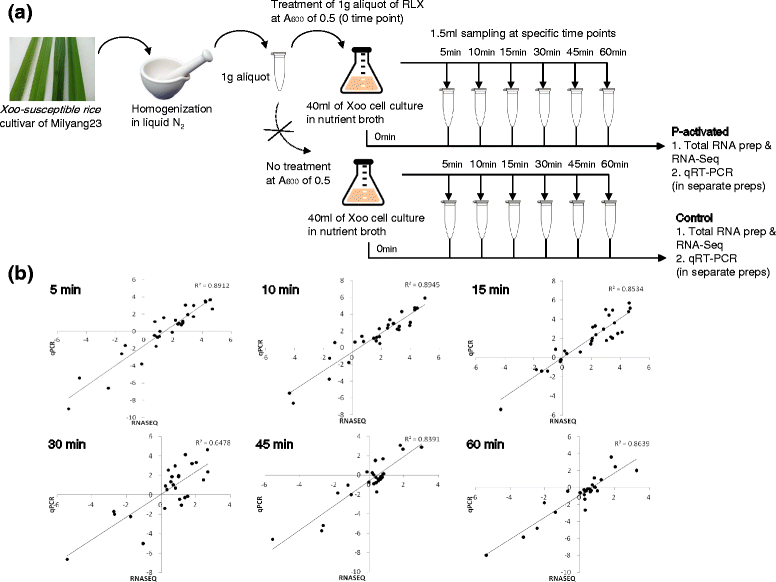
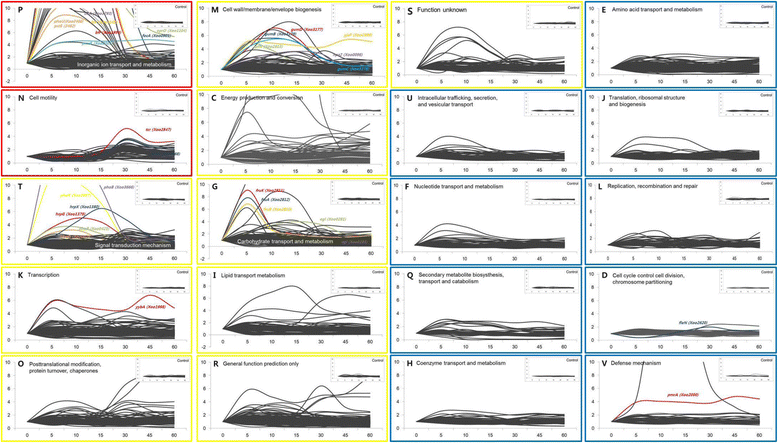
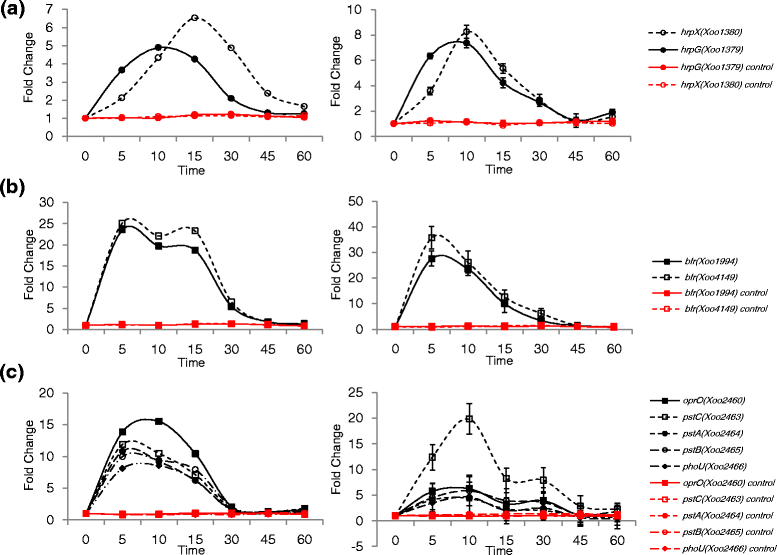
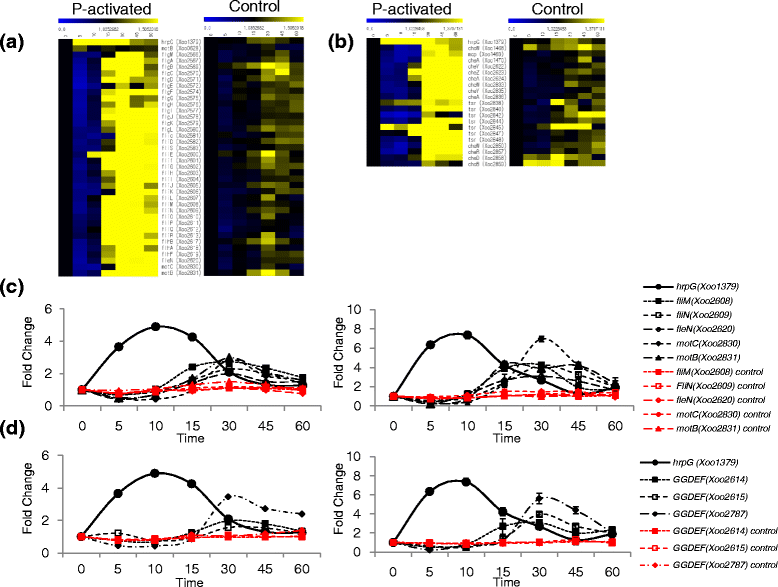
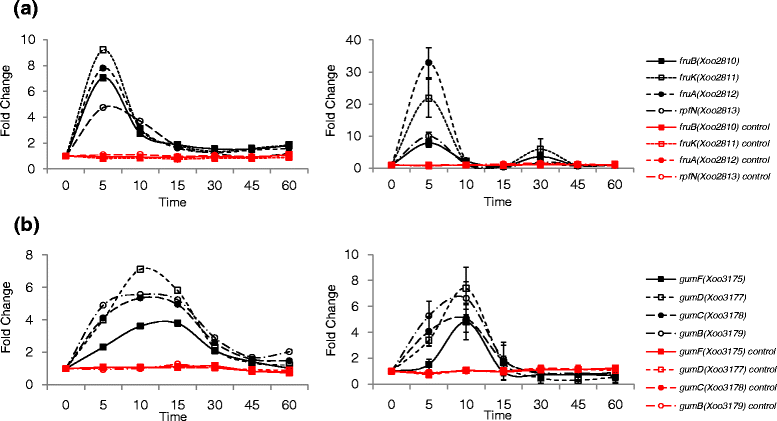
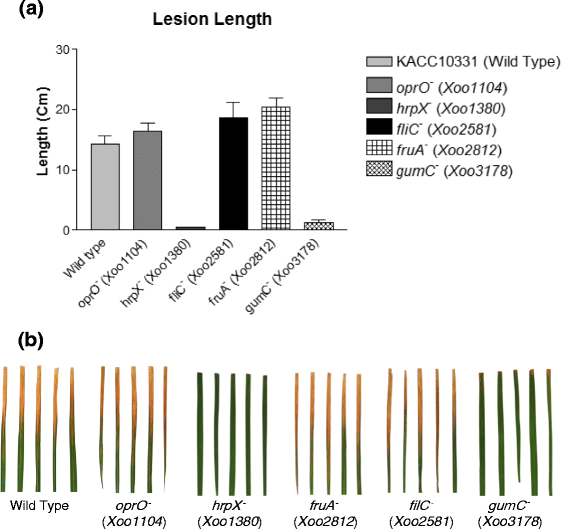
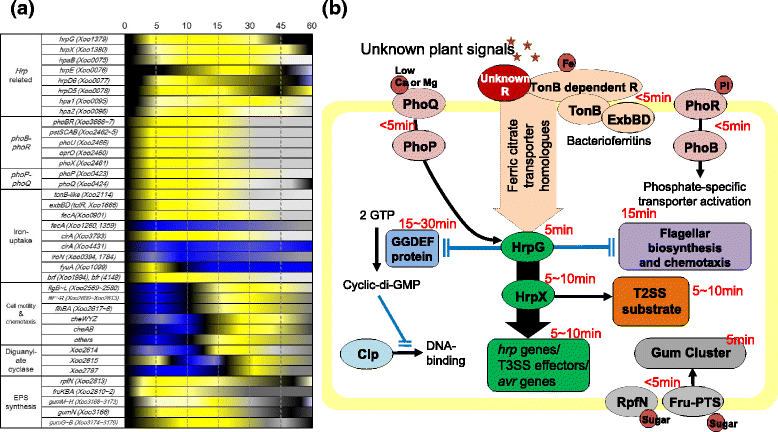
Similar articles
-
Two virulent sRNAs identified by genomic sequencing target the type III secretion system in rice bacterial blight pathogen.BMC Plant Biol. 2018 Oct 16;18(1):237. doi: 10.1186/s12870-018-1470-7. BMC Plant Biol. 2018. PMID: 30326834 Free PMC article.
-
GamR, the LysR-Type Galactose Metabolism Regulator, Regulates hrp Gene Expression via Transcriptional Activation of Two Key hrp Regulators, HrpG and HrpX, in Xanthomonas oryzae pv. oryzae.Appl Environ Microbiol. 2016 Jun 13;82(13):3947-3958. doi: 10.1128/AEM.00513-16. Print 2016 Jul 1. Appl Environ Microbiol. 2016. PMID: 27107122 Free PMC article.
-
Comparative Transcriptome Profiling of Rice Near-Isogenic Line Carrying Xa23 under Infection of Xanthomonas oryzae pv. oryzae.Int J Mol Sci. 2018 Mar 2;19(3):717. doi: 10.3390/ijms19030717. Int J Mol Sci. 2018. PMID: 29498672 Free PMC article.
-
Rice versus Xanthomonas oryzae pv. oryzae: a unique pathosystem.Curr Opin Plant Biol. 2013 May;16(2):188-95. doi: 10.1016/j.pbi.2013.02.008. Epub 2013 Mar 4. Curr Opin Plant Biol. 2013. PMID: 23466254 Review.
-
Rice Routes of Countering Xanthomonas oryzae.Int J Mol Sci. 2018 Oct 2;19(10):3008. doi: 10.3390/ijms19103008. Int J Mol Sci. 2018. PMID: 30279356 Free PMC article. Review.
Cited by
-
Transcriptome profiling of type VI secretion system core gene tssM mutant of Xanthomonas perforans highlights regulators controlling diverse functions ranging from virulence to metabolism.Microbiol Spectr. 2024 Jan 11;12(1):e0285223. doi: 10.1128/spectrum.02852-23. Epub 2023 Nov 29. Microbiol Spectr. 2024. PMID: 38018859 Free PMC article.
-
Transcriptome analysis of Xanthomonas fragariae in strawberry leaves.Sci Rep. 2020 Nov 25;10(1):20582. doi: 10.1038/s41598-020-77612-y. Sci Rep. 2020. PMID: 33239704 Free PMC article.
-
Two forms of phosphomannomutase in gammaproteobacteria: The overlooked membrane-bound form of AlgC is required for twitching motility of Lysobacter enzymogenes.Environ Microbiol. 2019 Nov;21(11):3969-3978. doi: 10.1111/1462-2920.14615. Epub 2019 May 23. Environ Microbiol. 2019. PMID: 30938049 Free PMC article.
-
Identification of c-di-GMP Signaling Components in Xanthomonas oryzae and Their Orthologs in Xanthomonads Involved in Regulation of Bacterial Virulence Expression.Front Microbiol. 2019 Jul 11;10:1402. doi: 10.3389/fmicb.2019.01402. eCollection 2019. Front Microbiol. 2019. PMID: 31354637 Free PMC article. Review.
-
Global Transcriptome Profiling of Xanthomonas oryzae pv. oryzae under in planta Growth and in vitro Culture Conditions.Plant Pathol J. 2017 Oct;33(5):458-466. doi: 10.5423/PPJ.OA.04.2017.0076. Epub 2017 Oct 1. Plant Pathol J. 2017. PMID: 29018309 Free PMC article.
References
-
- Mew TW, Alvarez AM, Leach JE, Swings J. Focus on bacterial-blight of rice. Plant Dis. 1993;77(1):5–12. doi: 10.1094/PD-77-0005. - DOI
-
- Suh JP, Jeung JU, Noh TH, Cho YC, Park SH, Park HS, Shin MS, Kim CK, Jena KK. Development of breeding lines with three pyramided resistance genes that confer broad-spectrum bacterial blight resistance and their molecular analysis in rice. Rice. 2013;6(1):5. doi: 10.1186/1939-8433-6-5. - DOI - PMC - PubMed
Publication types
MeSH terms
LinkOut - more resources
Full Text Sources
Other Literature Sources
Molecular Biology Databases

